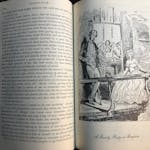Craig Cliff writes in his acknowledgments that the inspiration for this first novel, a historical fiction, was sailing ships and department stores. That combination results in a wacky two-pronged plot, at times moving, often entertaining and exuberantly told. It works because the writer is obviously having a good time, until he isn't and it doesn't.
The story begins in Cliff's native New Zealand, on the island of Maru Maru, in 1902. It is the dawning age of the department store, and already two of them have opened. Their fierce competition is embodied by the rival carpenters responsible for designing the display windows. One of them is mute, a man known as the Carpenter, who appeared mysteriously one day and dazzled the window-gazing crowd with his carving skill. The other is the second-rate and extremely frustrated Colton Kemp, newly widowed with twins to raise.
For 16 years the Carpenter's carvings continue to best Kemp's, until, after seeing the statue of Hermione come to life in a performance of "A Winter's Tale," Kemp gets a madly brilliant and horrible idea.
The narrative is taken up by his daughter Avis, who with her brother Eugen has endured an isolated and very peculiar childhood. Every day of their young lives has been an exercise in stillness. Kemp has trained them to hold various poses for hours without ever trembling. When they have mastered the final trick, of seeming not to blink at all (the actress playing the statue had blinked frequently), he deems them ready for the Window. Avis and Eugen assume all young people go through this rite of passage; they think they are on display to possible suitors. We, of course, know better.
Kemp, with his superb mannequins staging tableaux vivants of young lovers, has finally bested the Carpenter. But the latter, gazing hard at the beautiful creatures, grows suspicious and one day takes action.
Scene and narrator switch again as we move to an isolated cabin where the Carpenter writes down his life story. Now we're back in 1859 when he, Gabriel Doig, was born into a family of Scottish carvers specializing in sailing ship figureheads, usually women in flowing tresses. But he grows into adulthood in the era when sailing ships were giving way to steamboats.
When work grows scarce, he ships out to sea himself, an unlucky adventure that ends in a storm. He washes up, the sole survivor, on an uninhabited island we learn is part of New Zealand. Surrounded only by gulls and penguins, he spends an isolated year learning to forage, build tools and shelter, another Robinson Crusoe. He winds up in Maru Maru, where he leaves us to the third narrator, Eugen, to explain what happened after the Carpenter crashed the window.
Here is where the story flounders. Cliff has Eugen and his father roaming aimlessly in search of Avis. He doesn't seem to know what emotions to give them. They rage at each other in trite speeches, and we're subjected to some creepy memories. The novel collapses in inchoate violence. After preternatural stillness and great exertions on sea and land, we're left in a banal, stilted ending. Cliff's first book, a short story collection, won a prize, but he hasn't quite yet gotten the hang of the novel.
Brigitte Frase, a past winner of the NBCC's Nona Balakian Citation for Excellence in Reviewing, lives in Minneapolis.
The Mannequin Makers
By: Craig Cliff.
Publisher: Milkweed Editions, 325 pages, $16.





